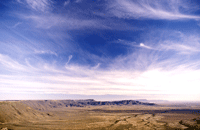 |


 |
|
||
  |
||
|
|
South Africa We are working in South Africa's Cape Floristic Region and the Succulent Karoo. These two areas of unique biodiversity are extremely threatened by unmanaged development. Succulent Karoo The Succulent Karoo, along the northwest coast of southern Africa, is remarkable for the diversity of plant species that live in its very harsh environment. A total of 4,849 plant species are found in the 112,000 square kilometers of the Succulent Karoo, and almost half of these live nowhere else in the world. The Succulent Karoo is also a center of diversity for reptiles and invertebrates. Threats The largest threat to the Succulent Karoo is the unmanaged use of resources. In particular, overgrazing of livestock and mining are jeopardizing the delicate diversity of the area. In order to sustainably regulate these pressures, we have joined the Succulent Karoo Ecosystem Planning (SKEP) process, which is bringing together stakeholders in a participatory process to develop a sustainable resource management plan. Projects Anglo American We are working with the Critical Ecosystem Partnership Fund, the Botanical Society of South Africa, local communities and Anglo American to establish a multi-partner-owned protected area in a priority region of the Succulent Karoo. more Cape Floristic Region The Cape Floristic Region, located at the bottom of the southern tip of Africa, encompasses an entire floral kingdom. The area has the highest concentration of plant species per unit area of any place in the world, with more than 8,000 known varieties. The majority of these species are found nowhere else in the world. The Cape Floristic Region is also home to endangered species found nowhere else on Earth, including the geometric tortoise, one of the rarest tortoise species in world; the cape sugar-bird; and several species of small antelopes, including the bontebok. Threats One of the largest threats to the biodiversity of the Cape Floristic Region is the expansion of certain sectors of agriculture. Land transformation for wine, olive and cut flower production is encroaching on pristine areas of the region. Project Wine in South Africa We are working with Conservation International South Africa and the Botanical Society of South Africa to develop a strategy to engage South African wine and brandy industry leaders to conserve the critical remaining natural habitat of the Cape Floristic Region by identifying and implementing biodiversity best practices in wine production. This effort is guided by a study completed in 2002 that identified critical natural habitat which may be threatened by the expanded production of wine and other agricultural commodities. 
|
 Succulent Karoo Hotspot.  WEBSITES • Succulent Karoo Hotspot • Critical Ecosystem Partnership Fund in the Succulent Karoo • Cape Floristic Hotspot • Critical Ecosystem Partnership Fund in the Cape Floristic Region • Anglo American • Botanical Society of South Africa |
|